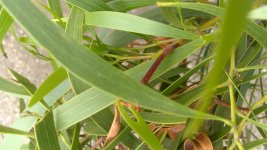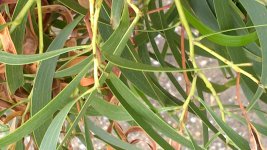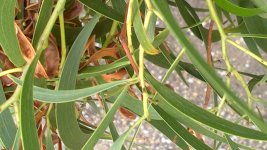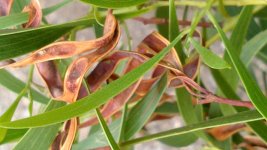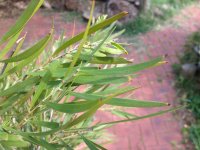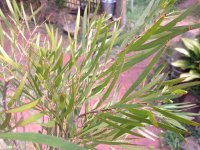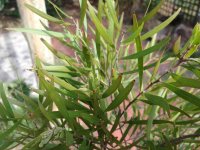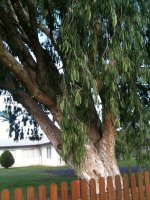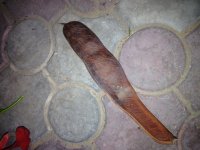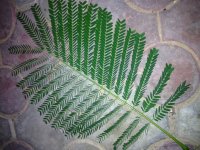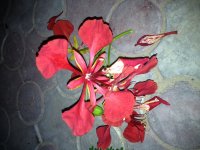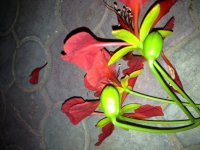Just one thing to keep in mind is that acacia's are often reduced in content during flowering... you could also try doing an extraction on a small amount before it flowers and see if anything comes of it..
-
Members of the previous forum can retrieve their temporary password here, (login and check your PM).
You are using an out of date browser. It may not display this or other websites correctly.
You should upgrade or use an alternative browser.
You should upgrade or use an alternative browser.
Botany Acacia and Mimosa Identification Thread
- Thread starter endlessness
- Start date
Growing logs with advice and results.
Migrated topic.
Blackandblue
Rising Star
so continuing with the mystery acacia which I recently posted in the info thread, I thought I'd add a few more photos to clear up a few characteristics that were missed in the other photos due to not so good lighting.. as you can see there are actually three prominent longitudinal veins accompanied by minor longitudinal veins moderately anastomosing.... the phyllodes have a stiff leathery texture and red edges. I have not located a basal gland either.. length of mature phyllodes = 7.8-7.9cm .. tastes bitter.
..hard to describe the smell upon burning.. i did a burning test side by side with an old phlebophylla phyllode and they had quite similar smell, though whether this could be attributed to alkaloids is a bit of a long stretch.. anyways will have a crack at it tonight and have results by tomorrow hopefully. unfortunately the photos seem to reduce in quality a little when directly uploaded to nexus.. but the veins should be fairly distinguishable
..hard to describe the smell upon burning.. i did a burning test side by side with an old phlebophylla phyllode and they had quite similar smell, though whether this could be attributed to alkaloids is a bit of a long stretch.. anyways will have a crack at it tonight and have results by tomorrow hopefully. unfortunately the photos seem to reduce in quality a little when directly uploaded to nexus.. but the veins should be fairly distinguishable
Attachments
wage.
Rising Star
Hey guys/girls.
I went for a walk on a trail a week ago to check up on an Acacia that had just started to flower. Half way along the walk to the tree, I came across another Acacia that looked like it had been cut down only a few hours earlier.
I was able to strip most of the bark and came back with a good amount. My only problem is, I don't know what species it is and I was hoping someone here could help with an ID.


I went for a walk on a trail a week ago to check up on an Acacia that had just started to flower. Half way along the walk to the tree, I came across another Acacia that looked like it had been cut down only a few hours earlier.
I was able to strip most of the bark and came back with a good amount. My only problem is, I don't know what species it is and I was hoping someone here could help with an ID.


..so the 2nd tree kiang posted on p17 is, as cleverly worked out by kiang, probably A. salicina..
pods, as always, one of the final means to be sure, as phyllode width can vary greatly..
EDIT: and wage..still studying the interesting vein pattern in your last pics..
pods, as always, one of the final means to be sure, as phyllode width can vary greatly..
EDIT: and wage..still studying the interesting vein pattern in your last pics..
apologies for the 1960's looking photos was using a terrible quality camera. first few are what i believe to be acacia mucronata subs. mucronata .. very similar genetics to the one in the backyard though further into flowering and slightly broader phyllodes which continue to grow further down the stems as they thicken... I wonder whether the one in the backyard is a hybrid with mucronata and something else?
next photo after those i believe to be acacia leprosa aka scarlet blaze? .. when i get a good camera i definitely plan on revisiting these trees.. its in an area where the sun shines right through the phyllodes in the afternoon and showcases their beautiful veins.. thats what i was actually trying to capture when I took them and I was dissapointed when i got home and uploaded them how blurry they were. I plan on replicating these in better quality soon. and they will be in flower when i do so hopefully :twisted:
i wonder if wage's mystery acacia (which we are certainly in abundance of here at nexus at the moment!) could be a form of acacia leprosa? the veins as well as the texture of the phyllodes look quite similar.. the phyllode shape seems wrong though, but as has been said phyllodes can vary quite a lot




next photo after those i believe to be acacia leprosa aka scarlet blaze? .. when i get a good camera i definitely plan on revisiting these trees.. its in an area where the sun shines right through the phyllodes in the afternoon and showcases their beautiful veins.. thats what i was actually trying to capture when I took them and I was dissapointed when i got home and uploaded them how blurry they were. I plan on replicating these in better quality soon. and they will be in flower when i do so hopefully :twisted:
i wonder if wage's mystery acacia (which we are certainly in abundance of here at nexus at the moment!) could be a form of acacia leprosa? the veins as well as the texture of the phyllodes look quite similar.. the phyllode shape seems wrong though, but as has been said phyllodes can vary quite a lot




JourneyToJah
Free Spirit
Could anyone give me an ID on this one ? Southern Spain area
 yfrog.com
yfrog.com
 yfrog.com
yfrog.com
 yfrog.com
yfrog.com
 yfrog.com
yfrog.com
 yfrog.com
yfrog.com
ImageShack - Best place for all of your image hosting and image sharing needs
Unlimited space to host images, easy to use image uploader, albums, photo hosting, sharing, dynamic image resizing on web and mobile.
ImageShack - Best place for all of your image hosting and image sharing needs
Unlimited space to host images, easy to use image uploader, albums, photo hosting, sharing, dynamic image resizing on web and mobile.
ImageShack - Best place for all of your image hosting and image sharing needs
Unlimited space to host images, easy to use image uploader, albums, photo hosting, sharing, dynamic image resizing on web and mobile.
ImageShack - Best place for all of your image hosting and image sharing needs
Unlimited space to host images, easy to use image uploader, albums, photo hosting, sharing, dynamic image resizing on web and mobile.
ImageShack - Best place for all of your image hosting and image sharing needs
Unlimited space to host images, easy to use image uploader, albums, photo hosting, sharing, dynamic image resizing on web and mobile.
JourneyToJah.. your tree looks similar to acacia retinodes.. which grows in spain
JourneyToJah
Free Spirit
Thank you, I have a couple of photos I took today that I think show it better.
Btw, is it active? The info in the wiki is a bit unsure.
Thank you!
Peace and love.
Btw, is it active? The info in the wiki is a bit unsure.
Thank you!
Peace and love.
acacianarchy
Rising Star
i don't think that is an acacia.. though the leaves look mysteriously phyllode like.. if it is, then it is not a species i am familiar with sorry. beautiful tree anyway
JourneyToJah
Free Spirit
An extraction has been performed on the previously posted A. retinodes using an A/B tek. Trunk bark and rootbark was used.
The result of the first pull was a very clear solvent, but after 20 hours it started to precipitate. It turned out a bit contaminated by organic matter. The bioessay was performed with 10mg on marijuana bed on a pipe.
It was not very visual neither OEV nor CEV but it definitely delivers a change on the state of mind, very thoughtfull and inspiring; and also quite long lasting.
May be an interesting discovery considering the lack of info on Acacia.
I will come back with some photos of the second pull precip.
Peace light and love!
The result of the first pull was a very clear solvent, but after 20 hours it started to precipitate. It turned out a bit contaminated by organic matter. The bioessay was performed with 10mg on marijuana bed on a pipe.
It was not very visual neither OEV nor CEV but it definitely delivers a change on the state of mind, very thoughtfull and inspiring; and also quite long lasting.
May be an interesting discovery considering the lack of info on Acacia.
I will come back with some photos of the second pull precip.
Peace light and love!
acacianarchy
Rising Star
Thanks acacian.
I can't remember exactly where,
But I read somewhere of an acacia species with 'floppy' leaves.
It matched the description of this particular tree but for the life of me I can't remember the name.
I have some other snapshots but I might wait and read into it a bit more.
E.S.O
I can't remember exactly where,
But I read somewhere of an acacia species with 'floppy' leaves.
It matched the description of this particular tree but for the life of me I can't remember the name.
I have some other snapshots but I might wait and read into it a bit more.
E.S.O
JourneyToJah
Free Spirit
Found a different one, acacian could you help ID this ? Both branches are from the same tree, its quite interesting how the leaves on one branch got so wide and the other are slim.
Peace light and love.
Peace light and love.
JourneyToJah... still pondering the new photos...they still look very similar to retinodes (which has variable phyllode width).. I was looking over your last ones and am now wondering whether they could actually be acacia saligna... saligna and retinodes are both very similar looking species though saligna has a greyer tinge to the phyllodes (until rubbed) which I noticed in your photos.. nen?
cant find an id for this tree, i thought its acacia but after searching for acacia with red flowers i just found the acacia leprosa. i doubt its an acacia
Attachments
i'm not sure what you've got there amrzhelmy... its not an acacia though
Similar threads
- Replies
- 4
- Views
- 86
- Replies
- 0
- Views
- 149
- Replies
- 6
- Views
- 713
- Replies
- 3
- Views
- 594


